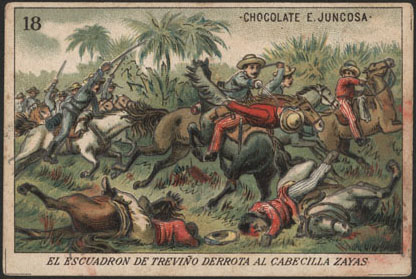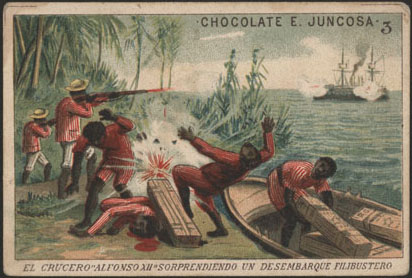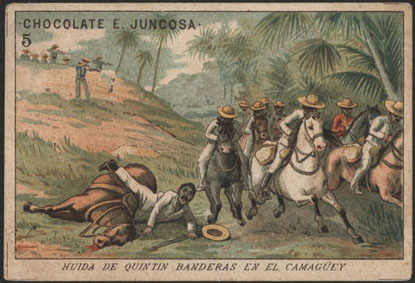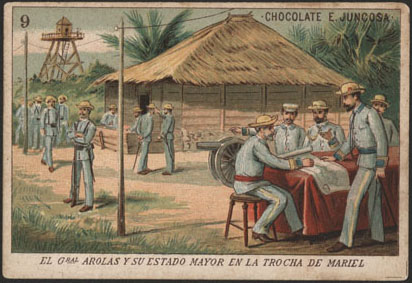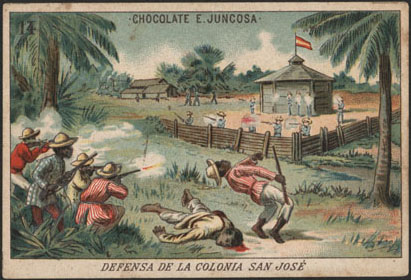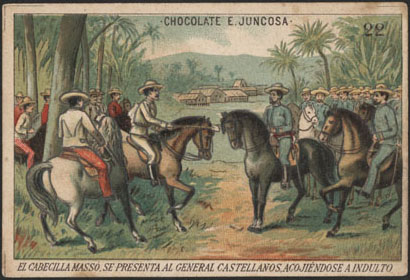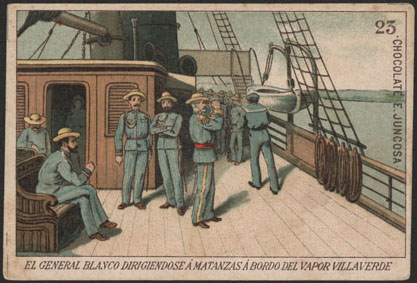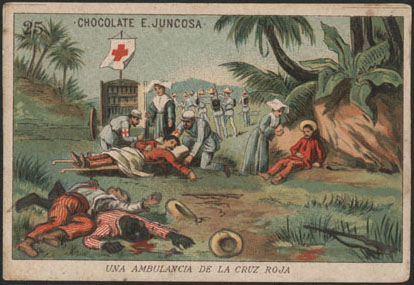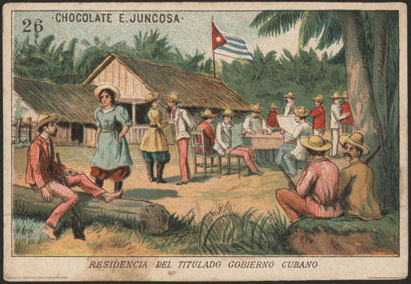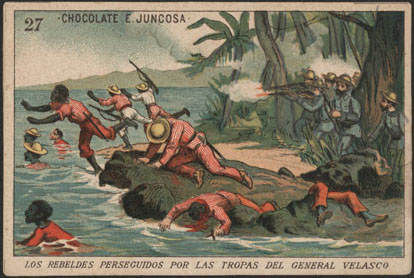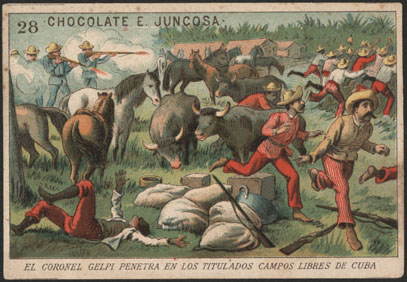Perspective and Truth
If one looks at these images without knowing the history, one might think that Spain won the war. The majority of the trade cards depict the Spaniards at the forefront, in a dignified, and victorious way. Whereas the Cubans are presented in a rudimentary manner, without distinguishing features, always in the run, injured, or defeated, and racialized subjects. If we look at the language used in the description at the bottom of each card, we can notice a common pattern when it comes to referencing the Cuban rebels.
One word, in particular, is repeated throughout the cards, the word cabecilla (ringleader), which bears a demeaning connotation in Spanish and is used to equate the Cuban leaders with bandits.
Another diminishing word used to describe the rebels’ actions is filibustero (filibuster). This type of language presented the idea that the war in Cuba was an affair of pillage, piracy, and bandits. Against this representation of the war, and keeping in mind that a ‘rudimentary’ enemy fought against Spain for ten years first, and then after a peace treaty and unfruitful strifes, the war began again for three more years, it is fascinating to consider how differently this war looked from the Cubans’ perspective. The Guerra Necesaria (1895-1898), as Cuba’s National Hero José Martí (1853-1895) baptized it, saw the remarkable organization of the Cubans inside and outside (mainly in the U.S) the island, the close collaboration with other Caribbean leaders, and the amazing fundraising for the financing of the war. Despite the biased portrayal of the war, a couple of truthful representations call our attention. First, the different places mentioned in the cards where the combats and military actions are taking place, and second, the presence of women among the Cuban rebels. On the one hand, these details confirm that the war engulfed the entire island, affecting every aspect of the economic, political, and social life, and pointing at the high levels of the strategy of the Cuban insurgents. On the other hand, the presence of women recognizes their role in anti-colonial politics, their active participation in the military, and the political wings of the independence movement.
Perspectiva y verdad
Si uno mira estas imágenes sin conocer la historia, podría pensar que España ganó la guerra. La mayoría de las imágenes representan a los españoles al frente, de una manera digna y victoriosa. Mientras que los cubanos se presentan de forma rudimentaria, sin rasgos distintivos, siempre a la fuga, heridos o derrotados, y como sujetos racializados. Si nos fijamos en el lenguaje utilizado en la descripción al pie de cada cromo, podemos notar un patrón común cuando se refiere a los rebeldes cubanos. Una palabra en particular se repite a lo largo de la colección, la palabra cabecilla. Esta palabra tiene una connotación degradante y se usa para homologar a los mambises cubanos con bandidos. Otra palabra que se emplea para describir las acciones de los rebeldes es filibustero. Este tipo de lenguaje sugiere que la guerra en Cuba fue un asunto de saqueo, piratería y bandidos. Ante esta representación de la guerra y teniendo en cuenta que un enemigo ‘rudimentario’ fue capaz de luchar contra España durante diez años primero, y luego de un tratado de paz e infructuosos levantamientos armados, la guerra se reanudó por tres años más. Teniendo en cuenta estos elementos es fascinante considerar cómo se veía esta guerra desde la perspectiva de los cubanos. La Guerra Necesaria (1895-1898), como la bautizó el Héroe Nacional de Cuba José Martí (1853-1895), experimentó la notable organización política de los cubanos dentro y fuera (principalmente en Estados Unidos) de la isla, la estrecha colaboración con otros líderes caribeños, y la increíble recaudación de fondos para el financiamiento de la guerra. A pesar de ser una representación prejuiciada de la guerra algunas de las imágenes muestran cierta veracidad. Lo primero que nos llama la atención son los diferentes lugares mencionados en los cromos donde se desarrollan los combates y acciones militares, y lo segundo es la presencia de mujeres entre los mambises cubanos. Por un lado, estos detalles confirman que la guerra se extendió a toda la isla, afectando todos los aspectos de la vida económica, política y social. Por otro lado, la presencia de las mujeres reconoce el papel que jugaron en la política anticolonial, su participación activa en el ejército y la política del movimiento independentista.
